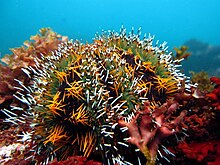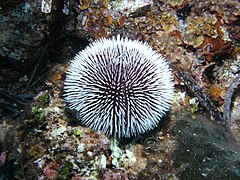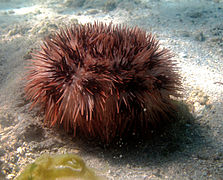
Lytechinus variegatus, commonly called the green sea urchin or the variegated sea urchin, is a species of sea urchin that can be found in the warm waters of the western Atlantic Ocean and Caribbean Sea.

Arbacioida are an order of sea urchins, consisting of a single family, the Arbaciidae. They are distinguished from other sea urchins by the presence of five separate plates around the anus. Unlike their close relatives, the Salenioida, all of the tubercles on their tests are of similar size.

Tripneustes gratilla, the collector urchin, is a species of sea urchin. Collector urchins are found at depths of 2 to 30 metres in the waters of the Indo-Pacific, Hawaii, the Red Sea, and The Bahamas. They can reach 10 to 15 centimetres in size.

Cidaridae is a family of sea urchins in the order Cidaroida.

Spatangus is a genus of heart urchins in the Spatangidae family. The genus is synonymous with the previously recognised genera Prospatangus Lambert, 1902 and Spatagus. There are nine recognised species. The type species is Spatangus purpureus Müller, 1776 by subsequent designation.

Toxopneustes pileolus, commonly known as the flower urchin, is a widespread and commonly encountered species of sea urchin from the Indo-West Pacific. It is considered highly dangerous, as it is capable of delivering extremely painful and medically significant stings when touched. It inhabits coral reefs, seagrass beds, and rocky or sandy environments at depths of up to 90 m (295 ft). It feeds on algae, bryozoans, and organic detritus.

The Camarodonta are an order of globular sea urchins in the class Echinoidea. The fossil record shows that camarodonts have been in existence since the Lower Cretaceous.

Holasteroida is an order of irregular sea urchins.
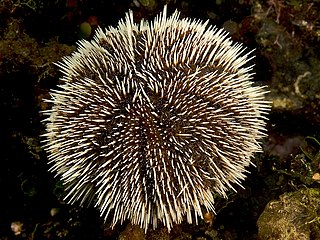
Tripneustes is a genus of sea urchins belonging to the family Toxopneustidae.
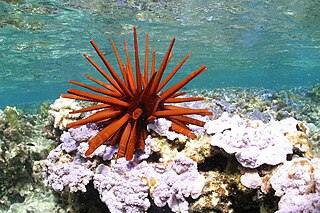
The Echinometridae are a family of sea urchins in the class Echinoidea.

Lytechinus is a genus of sea urchins.
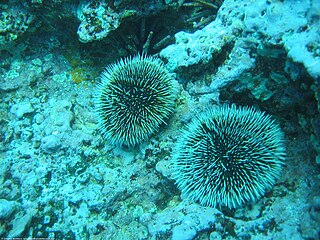
Tripneustes depressus, the white sea urchin or sea egg, is a species of sea urchin in the family Toxopneustidae. It is found on the seabed in the tropical eastern Pacific Ocean including Mexico, Panama, Ecuador and the Galápagos Islands.

Toxopneustes roseus is a species of sea urchin from the East Pacific. It is sometimes known as the rose flower urchin or the pink flower urchin. Like the related flower urchin, they are venomous.

Toxopneustes maculatus is a rare species of sea urchin found in the Indo-West Pacific.
Silvia Maciá is an American marine biologist and professor of biology at Barry University in Miami Shores, FL. Her research interests involves both laboratory and field work addressing pipefish mating behavior, seagrass community ecology, coral reef grazing ecology and seagrass restoration.
Schizasteridae is a family of echinoderms belonging to the order Spatangoida.

Echinoneidae is a family of echinoderms belonging to the order Echinoneoida.
